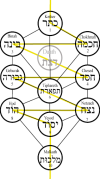Tree of Life

Kabbalah's tree
The concept of the Tree of Life is currently popular in teaching biology as well as in neo-mysticism and religions such as Kabbalah. Yet the notion is ancient, recurring in many philosophies and myths.
Life, then as today, is not fully understood even though we are all in that state; and death, was and is, understood even less. So we pass the mike to philosophy and mythology.
A tree's life-cycle is an ideal symbol for life in general. It grows up from being a seed to become a weak sapling, from a weak sapling to a strong tree, and before wilting, sheds its fruits to regenerate further identical trees.
In Egyptian mythology a particular sycamore tree was the gateway between life and death. Norse and Celtic swirls connect to European myths of the Tree of Life and there are similar in Mayan art and Daoist lore about a tree that every three thousand years bears fruit, the eating of which gives you immortality. But this page is not going to expand on any of those trees.
Our Tree of Life is the one introduced in the Book of Genesis and Proverbs.
Even people who take every word of the Bible literally will agree that this tree was more than just a physical growth of wood, with bark, branches and leaves. It was a tree that bore the fruit of everlasting life that God forbid Adam and Eve to take because they had disobeyed Him.
Fortunately for them, and now us, there was another tree a few thousand years after Adam, which was used to crucify Jesus. This tree bears fruit even today, which gives everlasting life. And unlike Adam, we are not forbidden to take the fruit. Indeed, we are urged to accept it.
See the meaning of the Cross.
See by way of example, the Grimms' Fairy Tales The White Snake and The King's Son Who Feared Nothing, and also The Pilgrim's Progress The Valley of Humiliation and Apollyon and Crossing the River to Reach the Celestial City.
The website of the Evangelical Free Church of America, efca.org, says their logo represents "strength, growth, diversity and clarity:
- The bold cross is the focal point of the logo, as the cross is the source of all spiritual life.
- The base of the cross represents both Calvary and our world, which Christ died to save.
- The leaves springing from the cross signify multiplication, and their varying sizes indicate the differing sizes of our churches.
- The vibrancy of the leaves' colors indicates health.
- The types of leaves represent diversity within our movement.
- Incorporating colors that are key to global and ethnic palettes, the color palette focuses on the future of our movement."
Dr Alexander Roman points out that the Tree of Life is a preconfiguration of the cross. See ukrainian-orthodoxy.org/... and also the Armenian Cross.

